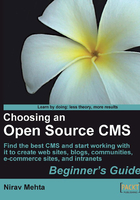
上QQ阅读APP看书,第一时间看更新
Time for action-determining compliance and interoperability needs
- By now, you are familiar with our Brainstorming Sheet— the paper sheet we used so far to list down intended outcomes and scale measurements. Pull that sheet or pick up a fresh one.
- Give a heading: Standards / Interoperability.
- Give a subheading: Overall.
- What are the web development standards we want to follow? Surely, we want the site to be done in strict XHTML. We also want it to follow WAI (Web Accessibility Initiative) guidelines for accessibility—making it usable for users with lower vision, hearing deficits, or other accessibility limitations. It's good to design the site using CSS layouts, so we want to comply with CSS3 standard as well. Start listing these below the Overall heading.
- We know that creating a Google Sitemap can get us better search engine rankings. As such, we also want to optimize our site for search engines. Let's put SEO (Search Engine Optimization), SEF (Search Engine Friendly URLs), and Google Sitemap too in our standards requirements.
- How about accessing the site from mobile devices? We don't want to work on developing phone-specific applications yet, so a mobile web site would do. As a matter of fact, ours could be the first Yoga site viewable even from mobiles! This would be a very good feature, so let's add XHTML MP (Mobile Profile) to our list.
- We are going to launch our site only in English for now, but we certainly want the ability to add content in other languages. This means we will need UTF-8 support too. UTF-8 text encoding is supported in all modern browsers and allows showing multilingual content. Our list may now look something like this:

- Give another subheading: Users.
- We want users to get the latest updates to our site via RSS feeds. This could be the main content feed or a feed of comments on some topic we have. Write down Subscription - RSS under Users.
- A similar feature will be letting people get yoga-related event information via the iCal standard. This will allow them to use calendaring systems to remember events. Let's add iCal for events to our list too.

- What are the ways in which we want to integrate with our vendors? We saw that a CSV product upload feature will make it easier for them to maintain their product or service listings. If we think about other partners, we may want to syndicate content from other partner sites on our site. So let's add a Syndication - RSS feature to the list as well.
- That covers most of the features we want. But there could be some other standards you want to comply with, or some other group of partners you need to interact with. Let's add another heading—Others—and add such requirements there. For example, we want to support FTP protocol for file uploads and HTTPS for secure logins and transactions. We may also want PCI Compliance for protecting credit card information. Think of anything else that you need on your site and add it to the list. Our additions may look like the following when done:

What just happened
We brainstormed and listed down our interaction points with our vendors, partners, and users. We also listed other standards we want to follow for our site. Listing standards like this makes site requirements clearer and forces us to think about the integration points before we begin working on the CMS.
Have a go hero-learn the terms
If you don't know them already, Google and learn about these terms:
- XHTML
- CSS
- RSS
- FTP
- HTTPS
- CSV
- SEO